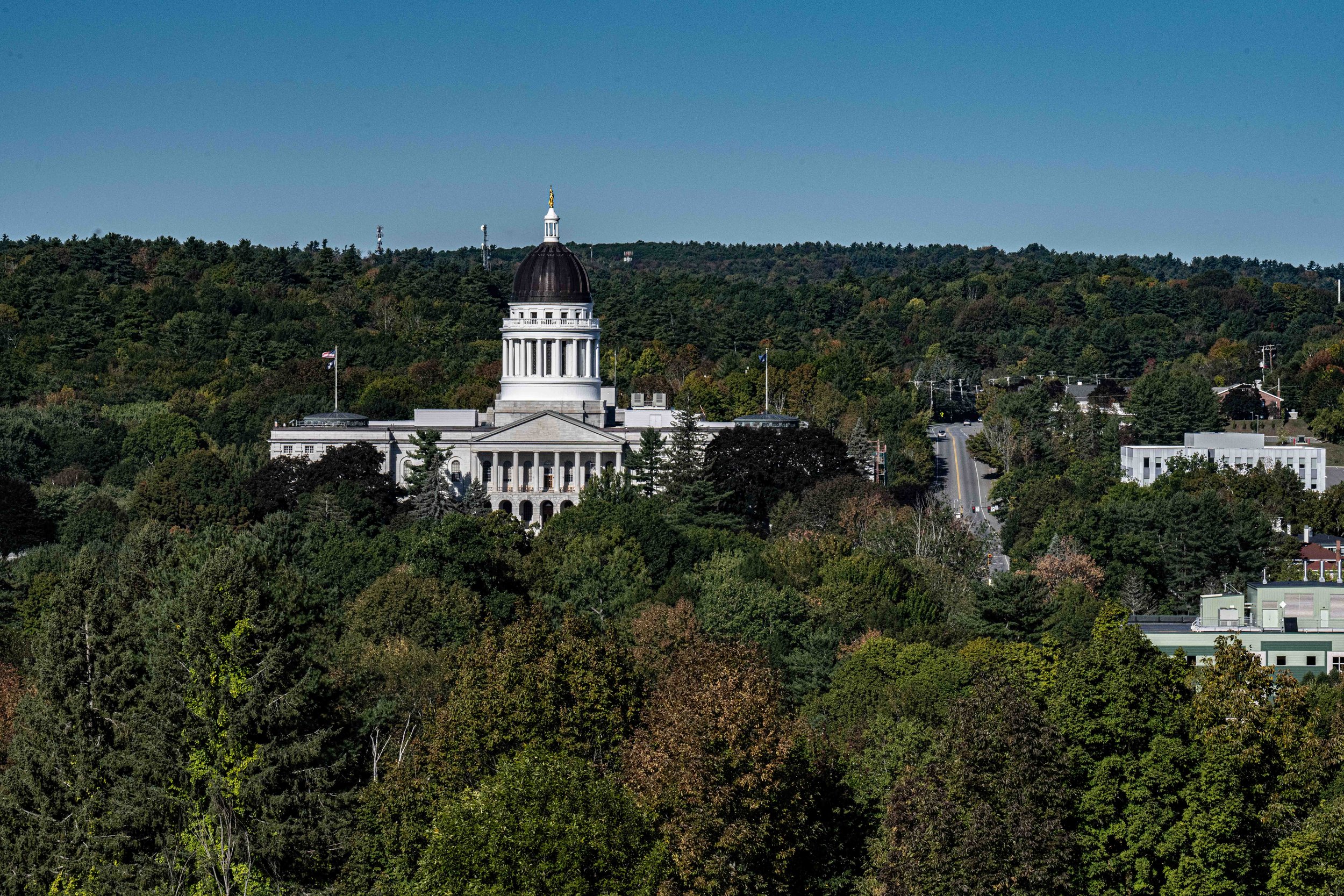Augusta Maine - The Capital
Augusta Maine
I drove into Augusta from the campsite and from a distance could see the dome of the capital. It was about a mile away on the other side of the river surrounded by trees. I thought to myself, how appropriate, given all the trees in Maine, and wondered if it was intentional.
The Maine State House was built from local Maine granite and completed in 1832. Maine was at one time part of Massachusetts which has its own history that I wasn’t aware of. From plaques I read around town, this evolved out of the Massachusetts Trading Company.
I took a walk from the capital into the mall area in front of the capital. At the far end of the mall was a monument to E. Lincoln, the Governor from 1827-1829. He was a distant relative to Abraham . The monument is not easily visible unless you walk all the way to the opposite end from the State House. I’ve also learned that Maine gained statehood at the same time as Missouri because at the time congress was trying to keep a balance between slave and non-slave states (extraordinary).
On the mall: A tree clawing its way off the capital grounds
Vietnam Veterans Memorial
Returning to the State House, on the right side of the mall is the Maine Vietnam Veterans Memorial. It’s a layered stone, iron, and steel sculpture that projects an image of soldiers rescuing a fellow comrade that has been wounded.
On the Mall: Maine Vietnam Memorial
Viles Arboretum
I had the Viles Arboretum on my list of things to see in Augusta. I really enjoy walking here because it took me back in time. Growing up, I lived across the street from Mattern’s Apple Orchard. This has the same feel with the tall grasses growing around the trees. The arboretum is organized by genus. I hiked the outer trail and stopped to read most of the educational material. There are about 6 miles of trails on this 225-acre property. They’ve placed sculptures around the property with price tags for would be buyers.
Viles Arboretum: Sculpture of a Bird
The American Chestnut research area was fascinating for me. They are trying to grow genetically modified seeds that will resist the blithe that had essentially wiped out the mighty American Chestnut. In the Overstory by Richard Powers, there’s a theme running throughout about the loss of the American Chestnut and one family’s history with a tree planted on their farm.
In the marsh section, I almost stepped on a large garter snake sunning itself in a small patch of sunlight. It scurried away as I just missed stepping on it.
Viles Arboretum: Marsh
Vaughan Woods Trail
Yesterday, Paloma and El gave me a few suggestions for places to take photographs. The Vaughan Woods was one of them. The trail sits at the top of the hill outside of Hallowell, ME. There’s parking for 12-15 cars. Luckily, a car was leaving as I arrived.
This was not a long hike but it is very picturesque. AllTrails calls this the Corniche Trail Loop via Corniche Trail. It’s a 1.9-mile hike. There is an old dam along the way, which is leaking, creating falls at the front of the dam. There’s sufficient water that creates cascading waterfalls along the stream. Add to this a stone bridge and trees leaning into the stream, it does create a nice photographic opportunity.
Vaughan Woods Trail: Couple by the Bridge
As I finished the trail, I met a couple looking for a trail map. They were worried that the trail might be too difficult. I showed them the AllTrails map and description, and they decided to do the trail. We shared travels, and before parting, they told me I should visit the botanical gardens in Booth Bay, Maine.
Vaughan Woods Trail: Three layers
Hallowell
It was past lunchtime and I drove down into Hallowell, located next to Augusta, to get a coffee and possibly something to eat. This is another old town with a long history rooted in fishing, lumber and trade. The buildings are mostly brick and like other towns in the area have recently been renovated to attract more visitors. It was 3:05 and the coffee shop closed at 3:00.
Halloway: Downtown Street View - Note the The River Room Restaurant & Maine Local Market
While walking down the street, there was a group sitting outside at a restaurant. One of them shouted out to me, come take our picture” as I was passing by the corner of a building. I came back, and the same person said to me, you must be a good photographer, you have a really nice camera. I agreed to take their photo. The group of friends from various places gave me an email address. That evening, I developed the image and sent it to them. I hope they enjoyed it. At least we all had a fun story to tell. They were fun to chat with. This wasn’t the first time this has happened I told them.
Halloway: Friends at lunch
I was too late for lunch or coffee it seemed, but I found myself at The River Room Restaurant & Maine Local Market. This is a farm to table type restaurant that just finished serving brunch. They did have coffee left and Monica, one of the owners, set me in back at a beautiful area overlooking the river. This looked like an excellent place for a good meal and there was a real friendly vibe, not just from the owners but the staff as well. Out front is a small shop offering local items. I wish I had been there for brunch.
I spoke to both the owners and they gave me some of the history of the area as well as a little bit of how they got into the restaurant business. They seem to be loving what they do, and are having success with the restaurant. They told me they enjoy working with the local farmers and getting creative with meals. From the google reviews this must be an excellent restaurant.
First Amendment Museum
I set off for the First Amendment Museum, but unfortunately it was closed. I did get some interesting thoughts on some of the history that led to free speech in Maine. It may be a story of natural resource availability and commerce leading to something deeper. From what several people described, Augusta became a leading trade center with furs, wood and other natural materials. Eventually, paper production began opening the way for printing. Printing evolved from newspapers to books, small bound publications and eventually magazines. Members of the Gannet family are buried in Hallowell. In fact the museum is housed in the Gannet family home.
August’s Publishing History provides a good overview of how E.C. Allen Publishing pioneered the low-cost mail order periodicals.
As a side note, you won’t find any billboards along the roads in Maine. In the 80’s, approximately 8500 billboards were removed from the roads after a billed was signed into law eliminating them. There are four states that do not allow billboards. The billboards were removed in Maine to preserve the the natural beauty of the landscape, catering to tourism.
Old Post Office
I drove back to August to get photos of the Old Post Office which is an example of Romanesque Revival architecture.
Augusta, Maine: Old Post Office Building
Museum In The Street
Throughout the streets of Augusta are signs that are part of the Museum in The Street walking tour. These are plaques that are strategically placed and provide a short description of some historical building or event.
I continued to walk and take photos near the river walk area.
Old Fort Western
In 1628, this was the site of a pilgrim trading post. As it evolved, it became a supply garrison in the mid-1700’s. The Howard’s, a prominent family in the 1760’s had a home here. The Gannet family are descendants of the Howards. The Augusta mayor said in his 2022 proclomation of this being The Year of the Fort states:
WHEREAS, in 1920 the Gannett family, descendants of the Howards, renovated the garrison, built reproduction blockhouses and watch boxes, and gave it back to the City in 1922 to be used as a museum; and
WHEREAS, Fort Western formerly opened its doors as a museum on July 4, 1922; and
WHEREAS, We all owe a substantial amount of recognition and gratitude to the people who have upheld and prospered at this site for the last 400 years, as history was being made and then remembered;
I toured the outside of the fort.
Augusta, Maine: Old Fort Western
Interior Designer In Hartford
As I was walking back across the bridge from the fort, I noticed a woman trying to get her walker situated at the end of the bridge. She was really struggling, and I asked her if I could help get her situated. She said she would be grateful. There was a 5 inch gap at the side of the bridge to allow for expansion, but there was nothing covering the gap. Her wheels kept getting stuck in the gap. She told me she wanted to sit and watch the birds. She lived on the other side of the river but didn’t have a very good view of the river. Her bag almost emptied into the crack as well. I rescued the bag and attached it to the walker. She finally got the brakes on and I could see her begin to relax. She was 91 years old.
We talked for about 45 minutes about politics, growing old, traveling, conservation and interior design. She worked for an architectural firm as their interior designer in the 60’s, 70’s and 80’s. She told me that in the 80’s, design went out the window as low-cost travel took over. She had worked in Hartford for many years on the famous hotels in the city. It was fun talking to someone in their 90’s that was so sharp. I hope I’m that sharp if I make it to that age.
Dinner in Halloway
I headed back to Halloway for a bite to eat. The area is very trendy and most of the restaurants were busy at 5:30 on a Saturday night. The first pizza restaurant told me it would be an hour wait. I remembered seeing another pizzeria at the other end of the street, Burano’s. They were able to seat me immediately. They gave me a large table to work at. They server wood-fired pizza which was excellent (prosciutto, arugula, Gruyere cheese, and tomato sauce). Around 7:00 pm a live band came on. For me, it's always fun to have live music.
It was a busy day and I was ready for a good nights sleep.













